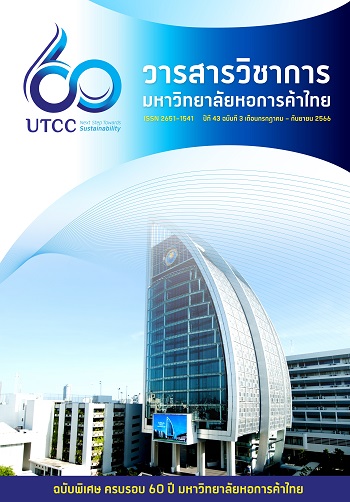Demands and Perceptions toward Marketing Innovation and Social Media Behaviors on Foreign Tourists’ Consuming Intentions for Wellness Hot Spring Tourism
Main Article Content
Abstract
The main objective of this research is to study the impact of demand and perception of
marketing innovation, as well as the communication behavior of foreign tourists through online social media on their intention to use wellness hot spring tourism. The study was conducted using quantitative research methods, with a sample of 200 foreign tourists surveyed. Data was analyzed using descriptive and inferential statistics, including multiple regression. The research results support the assumption that “meeting the needs of tourists and having a destination image that matches their needs will increase their intention to use tourism services.” However, the research did not support the assumption that the communication behavior of tourists through online socialmedia has an impact on their intention to use wellness hot spring tourism. This research can lead to the development of a marketing management model for promoting wellness hot spring tourism
in Mae Hong Son province as a destination for wellness tourism. This can be achieved through
the implementation of service marketing innovation and integration with various digital tools thatalign with the behaviors of tourists in present.
Article Details

This work is licensed under a Creative Commons Attribution-NonCommercial-NoDerivatives 4.0 International License.
ลิขสิทธิ์ของบทความ
ผลงานที่ได้รับการตีพิมพ์ถือเป็นลิขสิทธิ์ของมหาวิทยาลัยหอการค้าไทย ห้ามมิให้นำเนื้อหา ทัศนะ หรือข้อคิดเห็นใด ๆ ของผลงานไปทำซ้ำ ดัดแปลง หรือเผยแพร่ ไม่ว่าทั้งหมดหรือบางส่วนโดยไม่ได้รับอนุญาตเป็นลายลักษณ์อักษรจากมหาวิทยาลัยหอการค้าไทยก่อน
References
ศิวฤทธิ์พงศกรรังศิลป์, ธวัชชัย ศุภดิษฐ์, พิมพ์ลภัส พงศกรรังศิลป์, และสุชาติฉันสําราญ. (2563). การสร้างอัตลักษณ์ทางการท่องเที่ยวของน้ำพุร้อนเค็มคลองท่อม จังหวัดกระบี่.วารสารบริหารธุรกิจ มหาวิทยาลัยแม่โจ้, 2(2), 60-78.
สำนักงานเศรษฐกิจอุตสาหกรรม. (2560). 10 อุตสาหกรรมเป้าหมายกลไกขับเคลื่อนเศรษฐกิจเพื่ออนาคต. สืบค้นจาก https://drive.google.com/file/d/1zadt1anaKMAJbURVLFaeRNrJRbcGnt2d/ view?pli=1
Ana, M-I., & Istudor, L-G. (2019).The roleof social media anduser-generated-content in millennials’travel behavior. Management Dynamics in the Knowledge Economy, 7(1), 87-104.
Bakucz, M., & Kobli, A. (2016). A competitive analysis of spa tourism in Central European regions.Tourism & Hospitality Industry, Congress Proceedings, 1-17.
Balakrishnan, M.S. (2008). Dubai—a star in the east: A case study in strategic destination branding.Journal of Place Management and Development, 1(1), 62-91.
Balakrishnan, M.S., Nekhili, R., & Lewis, C. (2011). Destination brand components. International Journal of Culture, Tourism and Hospitality Research, 5(1), 4-25.
Boga, T.C., & Weiermair, K. (2011). Branding new services in health tourism. Tourism Review,66(1/2), 90-106.
Chen, K-H., Chang, F-H., & Wu, (Kenny), C. (2013). Investigating the wellness tourism factors in hot spring hotel customer service. International Journal of Contemporary Hospitality Management, 25(7), 1092-1114.
Chen, C.J., & Li, W.C. (2020). A study on the hot spring leisure experience and happiness of Generation X and Generation Y in Taiwan. Asia Pacific Journal of Tourism Research, 25(1), 39-51.
Csapo, J., & Marton, G. (2017). The role and Importance of spa and wellness tourism in Hungary’s tourism industry. Czech Journal of Tourism, 6(1), 55-68.
Dini, M., & Pencarelli, T. (2022). Wellness tourism and the components of its offer system: a holisticperspective. Tourism Review, 77(2), 394-412.
Esfandiari, H., & Choobchian, S. (2020). Designing a wellness-based tourism model for sustainablerural development. Research Square, 1-28.
Femenia-Serra, F., Peries-Ribes, J. F., & Ivars-Baidal, J. A. (2019). Smart destinations and tech-savvy millennial tourists: hype versus reality. Tourism Review, 74(1), 63-81.
Gertner, R. K. (2010). Similarities and differences of the effect of country images on tourist and study destinations. Journal of Travel & Tourism Marketing, 27, 383-395.
Global Wellness Institute. (2018). 2010 spa and the global wellness market: Synergies and opportunities. Retrieved February 2, 2022, from https://globalwellnessinstitute.org/industryresearch/spas-global-wellness-market/
Heung, V.C.S., & Kucukusta, D. (2013). Wellness tourism in China: Resources, development and marketing. International Journal of Tourism Research, 15, 346-359.
Huang, L., & Xu, H. (2018). Therapeutic landscapes andlongevity: Wellness tourism in Bama. Social Science & Medicine, 197, 24-32.
Israel, G. D. (1992). Determining sample size. Fact sheet PEOD-6.Florida: UniversityofFloridapress.
Kaplan, M.vD., Yurt, O., Guneri, B., & Kurtulus, K. (2008). Brandingplaces: Applyingbrandpersonality concept to cities. European Journal of Marketing, 44(9/10), 1286-1304.
Liu, Q., Browne, A.L., & Lossifova, D. (2022). Creating waterdemand: Bathingpracticeperformances in a Chinese hot spring tourist town. Journal of Sustainable Tourism, 30(4), 685-703.
Lovelock, C., & Wirtz, J. (2004). Service marketing: People, technology, strategy (5th ed.). Upper Saddle River, N.J.: Pearson Prentice Hall.
Oklobdzija, S.D., & Popesku, J.R. (2017). The link between digital media and making travel choices. Marketing, 48(2), 75-85.
Padhi, S.S. & Pati, R.K. (2017). Quantifying potential tourist behavior in choice of destination using Google Trends. Tourism Management Perspective, 24(2017), 34-47.
Panfiluk, E., Panasiuk, A.M., & Szymanska, E. (2017). Identification of the flow of innovations in tourism related to aesthetic medicine. International Journal of Management and Economics,53(3), 107-119.
Romao, J., Machino, K., & Nijkamp, P. (2018) Integrative diversification of wellness tourism services in rural areas – an operational framework model applied to east Hokkaido (Japan). AsiaPacific Journal of Tourism Research, 23(7), 734-746.
Saraniemi, S. (2010). Destination brand identity development and value system. Tourism Review,65(2), 52-60.
Zollo, A., Simonetti, B., Salsano, V., & Rueda Armengot, C. (2015). Promotion and marketing: Marketing strategies, Italy, regional development. In M. Peris-Ortiz & J. Alvarez-García (Eds). Health and wellness tourism: Emergence of a new market segment (pp. 63-76). New York: Springer.
Zuniga-Collazos, A., & Castillo-Palacio, M. (2016). Impact of image and satisfaction on marketing innovation. Journal of Technology Management Innovation, 11(2), 70-75


